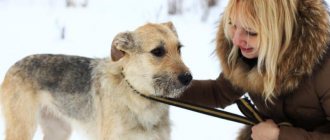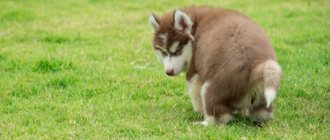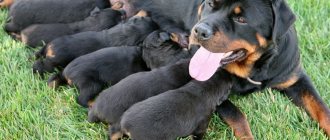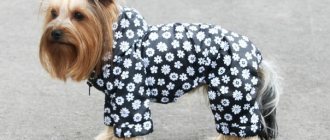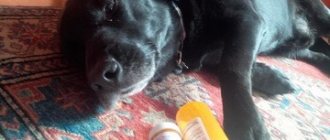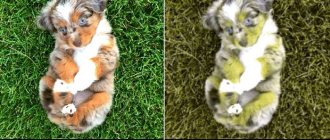The right relationship with the puppy must be established as quickly as possible. In this case, the reins of power should remain in your hands, but you should refrain from using force. Conduct yourself firmly and consistently, but with unfailing kindness. From the very beginning, the puppy must get it into his head that you are the leader. Believe me, this will make him much happier than possible doubts. Develop a code of rules, show the puppy where he sleeps. Establish a clear feeding schedule. Brush your puppy regularly - this is very important for establishing a trusting relationship. Only then will you understand how to become a leader for your dog
The dog's place in the family hierarchy
As a leader, the dog will only accept a person whose strength and power he will respect. It is him who he will trust and obey. At the same time, friendliness towards other family members is not excluded, but dominant manifestations are also likely. If you leave this unattended, the beast will grow uncontrollable.
A properly trained dog should know its place and occupy the last place in the hierarchy, only then will it be disciplined and obedient. To achieve this, it is important to socialize and adapt your pet from puppyhood.
The skills of correct behavior should be instilled gradually, consistently and persistently. When the dog understands what is allowed to him and what is not, he will avoid harmful habits, which would be difficult to wean an adult animal from.
The dog ranks last in the family hierarchy
Important! While admiring the furry little one, it is worth remembering that dogs, especially representatives of large and fighting breeds, feel like leaders by default, even at a tender age. If you do not correct your pet's behavior in time, the dog will grow up not just disobedient, but wayward and dangerous.
How to become a leader for your dog! Myths about dominance and exposing would-be cynologists.
Let's start with the fact that interspecific dominance does not exist.
Even if you are a three-times genius dog handler, you must remember that a dog is a dog, and a person is a person. Therefore, to say that you are the leader of your dog is complete nonsense! I don't know where this theory came from that a person must earn his place in the pack. Listen, this is your dog, and you are its owner, but not its leader. What kind of tendency is this: to gain the trust of your pet by force? Sit on him, bite his ear, bend under him. Tell me, have you made a friend? Or a whipping toy that must obey you? Only with trust and positive reinforcement can you raise a four-legged friend!
Forget all the online articles in which the authors give advice on how to become a leader for your dog. No way! You don't need to become a leader for your dog, you need to remain an owner, a friend, a comrade you can trust. Will a dog trust a person who systematically tries to force it under him? No! So what should I do? There are many approaches and techniques for raising a dog. Don't limit yourself to just popular TV shows and advice from armchair experts. Read serious books about education and contact with animals, for example: “Don’t growl at the dog!” It will immediately become clear to you how the relationship in the pack is built between fellow tribesmen, and the “master-dog” relationship. There is nothing in common between the way your four-legged friend interacts with other dogs and the way you interact with him. Only positive reinforcement and love can make a dog a truly loyal friend. Let's move on from theory to practice. So what do we have? Why did you get a puppy? Right - right! To love him, walk together and make his life and yours, of course, happier. Therefore, you need to become not a leader, but a friend. The theory is simple: we reward good behavior, we ignore bad behavior. This does not mean that everything is allowed for dogs. Not at all. Critical behavior is punishable. But! This is not beating the animal, but a severe punishment, for example - complete ignoring, a stern voice, refusal to play, you can even skip one feeding. Believe me, the dog understands perfectly well if it has done something wrong. And before you punish, understand the reasons for the action. Isn't it your own fault? If your dog has chewed your shoes, you may not want to leave them within the dog's reach.
As for serious offenses such as biting, aggressive behavior, and even attacks, here you have serious work to do with a dog handler. And, believe me, not a single competent specialist will advise you to respond to cruelty with cruelty. Having understood the root causes of this behavior, you will probably find your fault in the dog’s behavior. Correct, first of all, your behavior, reward the animal for following commands and good behavior. Bad behavior - punish by ignoring and restricting food. This will let your dog know that he can improve and get what he wants. You know, most aggressive dogs whose behavior can no longer be corrected were raised by monster owners. The dog simply defends its life, and it simply doesn’t know any other way to respond with aggression.
Let's look at one example: a puppy bites his hand painfully while playing. For this he gets a slap on the butt. That's it, friends, you have reinforced the behavior. The puppy was having so much fun, but you hurt him. Or - even cooler: in the best traditions of “I am your leader,” you pinned him to the floor and bit him. You have just shown your puppy that playing and having fun is bad. What would I do? In this case, I simply stop the game with a stern voice and leave. The puppy is bored and no longer having fun. With this behavior you will let him understand how he can play and how he cannot. If you don't bite, the game continues, if you bite, it ends. And no one humiliates anyone or pins anyone to the floor.
Treat dogs with understanding and they will do the same to you!
Signs of Dominant Behavior
You can make sure that your pet has chosen the role of leader of the pack when he:
- demonstrates reluctance to follow commands - understands everything, but persists, observing the person’s reaction;
- shows dissatisfaction and aggression towards the owner, other family members and pets;
- snaps at attempts to take his toys, rushes and tries to take them away;
- does not allow anyone to approach the bowl or bed - he takes a fighting pose and growls threateningly;
- shows aggression towards others during walks - rushes at passing people and dogs, barks at cars and cyclists.
If you get away with such behavior, the dog feels unpunished and becomes even more convinced that it is the head of the family.
When a dog sleeps on its owners' bed, it exhibits dominant behavior.
Time alone
You should train your puppy to be left alone for short periods of time every day. This will allow him to avoid being completely dependent on you, and will also prevent fear of loneliness and similar problems. Just take your time, even if at first the puppy has the opportunity to see you, but cannot get to you (a low partition in the doorway between rooms is ideal for this). Then close the door, leaving the puppy alone. Gradually increase your alone time sessions from 10 minutes to 1 hour. Leave as if nothing had happened, and under no circumstances return if the puppy starts whining. You can only approach him when he calms down. Praise him for his good behavior, but not too emotionally.
Source
Total Today: 1
How to show a puppy that the owner is more important
You should start with procedures related to care and maintenance. So, for example, while feeding a puppy, you need to add a little food into the bowl or, conversely, take some of the food out of it. The dog must recognize the owner’s right to do this and be calm about it. Another option is to feed your pet while holding the food container in your hands. So the dog will understand from an early age that the main moments of his life depend entirely on the will of the owner: as he decides, so it will be. This will allow you to avoid unnecessary manifestations of dominant behavior in the future.
Feeding a pet by hand is an element of proper upbringing
The same goes for toys. It is worth periodically trying to take your favorite item from your dog. Did you unclench your teeth and give it away? Great. The toy should be removed and returned after a while. If the dog stubbornly holds onto the item, you should not fight him, trying to take it away. You should wait for the moment when he lets go of the toy himself and take it away... forever. Exactly. When an animal shows aggression, seeing that a person is trying to take the game object left by it, you should take the pet to a cage or another room, where it will be locked for a short time. The point of such an act is for the dog to understand: in order to avoid unwanted consequences, it is better to obey.
We take the toy and return it after a while
Dog toys
Another important point is caring for the coat, eyes and teeth. This is not just hygiene measures, but also an important educational moment. You should be careful in your actions so as not to cause the dog unnecessary discomfort and pain. You should start the procedure with stroking, and then start combing the fur, cutting out tangles and other manipulations. The dog must understand that whether he likes it or not, hygiene will be carried out regardless of his desire. What and how to do is decided by the owner, so it is useless to resist. Over time, this will become commonplace, the dog will get used to it. An untrained pet will show dominant behavior every time - growl, bark, try to bite. This is fraught with injury and greatly complicates the procedure for a routine examination at a veterinary clinic.
Removing mats from a dog
Who is the boss of the pack?
Domestic dogs are the heirs of wild wolves, or rather, large, steppe, very strong hunters from the canine family. Animals cannot speak, but living in communities they were forced to find ways to communicate with each other. Canines have invented one of the most complex languages for communication. Both wild and domestic dogs use a complex of sounds, gestures and smells to communicate. The hierarchy of dogs is usually considered using the example of wolf packs.
There are several niches or ranks within a wolf pack. The alpha pair is considered the main one, consisting of the leader of the pack and the dominant female. The next, beta niche may consist of one or more pairs of young wolves. Gamma pack members are young wolves and she-wolves who have not yet found a mate. Omega pack members are old wolves and young ones.
- The alpha pair , mostly the leader (male), is responsible for the safety and general way of life of the pack In the absence of the leader, the alpha female makes important decisions.
- Beta couples replace the leader and alpha female in critical situations, and in everyday life they completely obey them.
- The status of gamma pack members is uncertain until they have found their mate. Most of the young males leave the pack and occupy neutral territory. Independent males cannot cross the border of the pack's territory, but members of the pack do not violate the boundaries of an independent wolf. The preservation of the integrity of the territory is monitored by guards who belong to the gamma niche. It is gamma wolves who monitor the safety (omega) of young and older members of the pack in everyday life.
Note! Hierarchy is a certain order of distribution of power. Under normal conditions, a flock can be led by both a female and a male, who mutually replace each other.
Let's figure out what the role of the leader is. The leader of the pack does not participate in everyday “troubles”, such as caring for puppies or constantly patrolling the territory. During the hunt, the leader directs the movement of the pack, and if the hunt is successful, the “first piece” goes to him. The flock patiently waits for permission to approach the prey or until the alpha satisfies his hunger and only then begins to eat. At the same time, it is the leader who is responsible for the safety of each member of the steel and enters into battle if the inviolable border of the territory has been violated.
Each male from the gamma niche can lay claim to the position of leader of the pack. In order to take a dominant position, males or females will have to fight with the leader. Note that the pack does not support the rebellion and will act on the side of the current leader. The battle usually takes place fairly, the wolves fight one on one and the strongest becomes the leader. This mechanism allows the leader to be removed when he becomes old and cannot defend the territory. The decision on whether the deposed leader of the pack will remain in the pack is made by the former leader. Quite often, former pack leaders cannot stand defeat and leave, becoming independent wolves.
How to show your older dog your leadership
This is not difficult if you systematically adhere to the following rules of conduct:
- Always enter the room first. This applies to both entering and leaving the house and moving from room to room. When the dog is nearby, he should not pass before the person. In their natural habitat, the wild ancestors of domestic dogs did exactly this: the leader went first. The same applies to behavior while walking, as well as going up and down flights of stairs. When a dog runs ahead of its owner and does not listen to his commands, it considers him to be a subordinate.
This dog clearly dominates its owner
- Do not step over the dog when it is lying on the floor and blocking the room. You should give the command for her to go to the bed, and then continue on her way. Of course, this applies to situations where there is enough space in the apartment for the animal to rest without disturbing the owners. Otherwise, you shouldn't have a pet at all.
- Do not give the animal food from the table and do not feed it before the owner and family have had dinner. The leader must eat first, this is the law.
- Show patience and fairness to your pet, but remain friendly. The leader of the pack must have a strong spirit and be honest. Dogs see this and respect it.
Patience and justice will bear fruit
- Do not allow rude behavior without a reason, do not take out a bad mood on your pet. Otherwise, the dog will grow up fearful and get used to “snarling” in response. In such a situation, it will be difficult to become a leader for the dog, much less a friend.
- Control joint games that are competitive in nature. The person should be the winner, but the dog should receive encouragement for his efforts and will to win. An owner who always wins is an excellent mentor and a good example for the animal. It is also worth remembering that the initiative to start and finish the game should always come from a person.
Two people play - the owner always wins
- Do not allow the animal to lie on sofas and beds where people sleep, or to lie on top of family members. In the understanding of the beast, moving to a higher and more comfortable territory means moving towards leadership, and lying on a person’s back or stomach is nothing more than a demonstration of one’s own superiority. In this case, the pet should be grabbed by the withers and forced to jump to the floor. After this, place it with its paws up and hold it in this position for several seconds. Some dog handlers recommend holding the dog by both cheeks at this time and looking strictly into his eyes until he looks away. In the case of large and adult dogs, this is dangerous. It’s better to just take them to a cage or place.
I hold the dog by both cheeks and look into its eyes.
- Be able to give commands correctly. It's not just about the tone in which they should be pronounced, but also about logic. A dog that has carried out an order can be misled by repeated repetition of a command phrase. That is, when the dog is sitting and it is necessary for him to remain in this position for some time, you should not repeat: “Sit!” It’s more logical to say: “Wait!” In order for the dog to understand and follow orders, the owner must be able to give them as expected. This is worth learning before you start training an animal.
Important! Be attentive and caring towards your pet. Dogs understand and really appreciate this attitude towards themselves, so they respond with love and loyalty.
The leader in the family should always remain a person
You can find out more about the methods and methods of training dogs of various breeds in a special section on our portal.
Case from practice
Tizzy, Dalmatian, 14 weeks
Circumstances: Lives in the family of Martin, who has three children aged 8 to 15 years.
The essence of the problem: Constantly gets underfoot, demands attention, chews children's toys and clothes.
Explanation: This behavior is completely normal for a Dalmatian puppy, but the family is asking for advice on what to do to prevent bad habits from getting worse in the future.
Recommendations:
- When Tizzy gets particularly fussy, take him out for a short walk (20 minutes is enough for his age), or start an active game outside.
- Create conditions for the puppy to rest so that he is not touched and he does not pester anyone. Leave him in a separate room or playpen for short periods of time. Put his bedding there too. After any solitary confinement, reward Tizzy with treats until he gets used to being alone sometimes.
- Tizzy should have his own toys. You should not scatter them around the house, but it is better to give them to the puppy at a certain time.
- Children should not throw clothes and toys around; they should be kept out of the puppy’s reach.
- A puppy crate in the corner of the living room allows your puppy some alone time. Place his bedding and toys inside.
Such problems include, for example, frantic greetings. Many puppies get so excited by the arrival of guests that they jump up on them to express their love. It's good when a dog is kind, but you shouldn't let it sit on your head. Make it so that the puppy has to greet guests more often, and then the thrill will disappear. And ask your guests to ignore the puppy until he calms down and stands on all four paws. And when you return home, do not express your intense joy at meeting the puppy, although this is not easy.
Another manifestation of unwanted behavior that needs to be eradicated initially is play biting. Puppies, growing up, often use their needle-sharp teeth during active games with their peers or their mother. If the bite is painful, the affected puppy will yelp or growl. An adult dog will growl more often and move away from overly naughty kids. And you can follow her example if the puppy bites your hand or trouser leg. Let out a loud scream, growl menacingly, and leave; There is no worse punishment for a puppy than being deprived of attention. Let it sit alone for 5-10 minutes and cool down. If after this the puppy continues to pester you, throw him some object that he can chew painlessly, for example, an edible bone.
What to do if the dog is disobedient and aggressive
First, you should understand that the reason for this behavior is improper upbringing. Secondly, take steps to teach your pet good manners and respect. On the Internet you can find different opinions on this topic:
- Some concern recommendations on how to independently correct the dog’s behavior. Supposedly, if he is disobedient, but does not show excessive anger, he can fix everything on his own;
- others advise seeking help from a dog handler;
- still others believe that it is better to get rid of the “wrong” animal.
It is worth understanding that without the help of a specialist, an owner who has raised a wayward and disobedient dog is unlikely to be able to change anything. That is why the best solution would be a special training course under the guidance of an experienced instructor. Another advantage of the method is that the dog trainer will not give general recommendations, but precisely those that will help change the behavior of a particular dog. In addition, he will show in practice how to apply them.
A dog trainer will help you eliminate errors in raising your pet.
Important! As for the choice to get rid of an aggressive dog, this can only be justified by a real threat to the safety of family members. If you approach the issue in a civilized manner, it is worth choosing a new owner for the dog who is familiar with the characteristics of the breed and has the knowledge and experience to turn the animal into an adequate pet.
We teach the dog the right skills
Even if you have extensive experience in communicating with animals, in particular with dogs, and consider yourself an unsurpassed trainer and educator, you will never achieve proper success if the dog does not perceive you as a leader, the leader of his pack.
Important! Dogs are accustomed to living in a pack under the leadership of a dominant leader. The leader of the pack must establish certain rules and strictly monitor their implementation.
Dog breeders must understand that for a dog, the leader of the pack is the one who constantly confirms his leadership. Once you stumble, show your weakness, break the established rules, your authority in the eyes of the dog will be lost. Therefore, when raising a pet, show patience, determination, and perseverance.
You always need to be moderately strict and decisive with a dog At the same time, do not forget that the dog is a social creature that also needs affection, love and care. Therefore, we recommend finding a “golden” mean in communicating with your beloved pet. It is immediately worth noting that males, regardless of breed, if they do not adapt correctly, will constantly try to challenge the dominant position of their owner (leader). According to dog laws, it is males who most often get into fights with their relatives. The outcome is always the same. The dominant male will win, the weak male will step aside or submit.
First pet
When wanting to get a dog, many choose large breeds, citing the fact that their intelligence is higher than that of small ones. This means that the pet will understand the owner better, which means that the level of communication with the dog will be completely different. In addition, the prospect of raising not only a four-legged friend, but also a reliable protector and guard is captivating. At the same time, the mental features of some breeds are missed, which require increased attention and special behavior correction.
Dogs prone to dominant behavior are not suitable as a first pet.
If the future owner does not have experience in raising and raising dogs, it is better to purchase a companion animal as a first pet. They are less prone to dominant behavior and are not dangerous with sudden aggression.
Table 1. Dogs recommended and not recommended as a first pet.
| Dogs with a high tendency towards dominant behavior | Companion dogs |
| Caucasian Shepherd Dogs | Collie |
| Bull Terriers | Toy poodles |
| Dobermans | Labradors |
| Cane Corso | American Cocker Spaniels |
| Rottweilers | Yorkshire Terriers |
| Alabai | Golden Retrievers |
| American Bulldogs | Pomeranians |
| Pit bull terriers | Pugs |
Important! Those who definitely want to become the owner of a representative of the fighting breed should plan a special training course. It is also worth keeping in mind that representatives of working and hunting breeds should have the opportunity to realize their abilities in business; if not, they can cause a lot of unpleasant troubles to the owner.
Behavior rules
Showing a dog who is the leader in the house is quite easy, but at the same time you will need to live by dog laws, constantly confirming and strengthening your authority.
Important! Swearing, loud screams, beating, and rough treatment of an animal will not only not give the desired result, but can also provoke an absolutely opposite effect. Such an approach towards a pet will lead to mental disorders. The dog can become cowardly, uncontrollable, and aggressive.
And so, if you are interested in how to show a dog who is boss and leader in the house without using violence, follow these rules:
- The dog must know its place. Do not allow your pet, including a puppy, to climb onto your sofa, bed, or chair. The dog should not sleep next to its owner. In this case, your authority as the leader of the pack will be undermined. Provide your pet with a convenient, comfortable place to rest and sleep, where the dog will feel private and safe.
- Do not allow your dog to show aggression if you want to take away his ball, favorite toy or stick on the street. Stop the roar with a stern tone. The dog should allow you to approach its place, bowls, and toys. But this does not mean that you need to spread rot and humiliate your pet. The animal must have its own personal territory.
- Eliminate games that develop aggression or allow dominance (pulling the leash, other entertainment in which the dog uses his teeth). If the dog belongs to the service or fighting breed, the initiative in joint entertainment should belong to you.
- Prohibit your dog from chewing furniture and interior items . The dog must know discipline. If your pet has done something wrong, show your displeasure with all your appearance and scold the animal for its wrongdoing. Although dogs do not feel guilty, the dog, when showing his love, understands by his tone that his action has upset you.
- Feed your dog only after your meal . Do not give treats from your table; besides, such forbidden “treats” are not very beneficial for your pet’s health.
- When returning from a walk, always enter the house or apartment first . This way you let your pet know that he is entering your territory and must obey the established rules.
What is dominance
This concept is quite vague, not all dogs strive to dominate; in some dogs these manifestations are pronounced, while others do not have such a tendency. Many pets try to dominate only at home, but on the street they are quite good-natured and sociable. And sometimes the situation is different, and then the dogs confirm their superiority during walks, bullying other dogs and even encroaching on people.
Naturally, dog handlers are interested in the peculiarities of this behavior of dogs, and they study the dominance of these animals, drawing a line between domesticated individuals and their wild ancestors - wolves. Several theories have been put forward, and each of them is supported by evidence, but the exact mechanisms have not yet been studied.
Two types of dominant behavior have been identified:
- due to the anatomical and physiological characteristics of the animal;
- arose against the background of improper upbringing or lack thereof.
The owner should take a closer look at his four-legged friend to figure out in what cases he demonstrates dominance and what this is connected with. A dominant dog not only loves to fight - he has persistence and stubbornly moves towards his goal. He is not afraid to break established boundaries and rules in order to once again test his position in the pack, and the owner needs to be on guard.
If the owner misses the manifestation of willfulness on the part of the pet and does not react in any way, he will decide that the early laws have lost force and victory is his. He will encroach on leadership positions more than once, again and again confirming that he is worthy of being a leader and will one day take this place.
For example, a dog suddenly, for no reason, begins to climb onto the owner’s sofa and defiantly lie on it - not in the absence of the family, upon the arrival of whose members he runs away and pretends to be innocent, but in front of everyone. He had not been allowed to do this before, and he will wait for the owner’s reaction.
What are the signs that a dog considers himself a leader?
- Ignoring the owner’s commands, although you know for sure that he followed them and, in some conditions, continues to do so. It is questioning your leadership and claiming your own.
- Any signs of aggression: growling, baring teeth, snapping teeth, freezing if you approach him or his property. This is a claim to peace and ownership, available only to the leader.
- An animal running does not try to get around a person, but crashes into him. This is a requirement to give way.
- Attempts to mount people. This is a demonstration of superiority.
- The dog does not obey when you try to drive it away. This is also a demonstration of the leader's position.
- Direct look at point-blank range. This is an attempt to suppress, a direct threat.
How to let the dog know “who’s boss”
The techniques for establishing leadership are the same for puppies and adults, but the intensity of the impact varies depending on who came into your home: a doggy baby or an improperly raised dog. In the second case it will be more difficult; correcting is always more difficult than teaching right away.
So, let’s learn a simple truth: you are the leader, the members of your pack are your subordinates, the dog is the lowest in the hierarchy.
Leadership, by the way, does not justify or support your causeless aggression and cruelty towards animals. On the contrary, they greatly undermine the position of the leader. In a normal pack, he will never cripple, mentally or physically, or kill his subordinates. He always punishes fairly and only until the dog shows obedience and submission. By the way, you can read about how to properly punish a dog. Animals do not know how to lie and be hypocritical, and if submission is demonstrated, then it is meant.
Food
The leader eats first. This means that you need to feed the dog after family members have eaten. Handing pieces from the table to a beggar is unacceptable; the leader does not show weakness and does not share his lunch.
Rest
Sleeping on a hill is the privilege of the leader. A dominant dog should be prohibited from accessing chairs, sofas, and beds.
Play and caress
The initiative comes from the leader—you. Toys and devices for playing remain at the disposal of the latter. Do not give in to provocations when the dog comes up and pushes you, demanding affection or play. Even if you were planning to play a second ago and the pet considered your thoughts and came up, show restraint and start the game after a while, ignoring the dog until then. Stop the entertainment first, too, without waiting for the dog to leave.
Job
Give your pet commands more often so that he feels “in charge.” Always get things done. The most useful exercises in this regard are endurance exercises; they provide excellent discipline and help emphasize power.
Movement
While walking, do not step over a lying dog, lightly kick it in the side, push until it moves away. The leader goes where he wants and always goes first, entering somewhere and leaving somewhere, push the dog behind you.
Stopping unwanted behavior
Most often this concerns aggression towards people. To do this, lift the dog by the scruff of the neck and shake it, if its size and age allow. If not, the animal can be quickly, confidently, firmly turned onto its back and pressed to the floor. Hold until it stops resisting, starts whining and/or takes on a submissive appearance (lays quietly, looking away). Do not overdo the frequency of this demonstration of leadership; if the dog is large and aggressive, he may begin to defend himself. You can press him to the floor by the scruff of the neck without turning him over, this is what old leaders often do with arrogant teenagers.
At first glance, it seems that by fulfilling all these points, you will turn your life and the dog’s life into hell and there is no question of any positive interpersonal interaction. Actually this is not true. The full range of these measures is required only in the case of correction of the behavior of an adult neglected dog, strongly prone to dominance. Dogs are also different and not everyone shows a pronounced tendency to lead; the degree of this personality characteristic varies, just like in people.
Problems and errors
- Non-serious perception of the baby's behavior. Puppies are always underestimated, even if they are giant furry “Caucasians” or “Alabais”. Doesn't he growl and wince charmingly? Do not allow this under any circumstances. Growls when you try to eat, train your endurance by taking away the bowl of food. He grins when you try to touch him or his toys, confiscate them and give them out only during the game, taking them away later. Suppress any manifestation of aggression as indicated in the paragraph “suppressing unwanted behavior.”
- A pity. It’s one feeling for a puppy, he’s small, sweet, and I’m just so sorry for him. In relation to an adult dog, this is usually remorse, how can it be that you oppress him, put him in last place in the house, and don’t “respect” him at all. Remember, the dog does not need your respect and pity; almost every pet has a desire for leadership, and he will make attempts to win it. But this does not mean that the dog will be deeply unhappy if his place is “last on the edge.” For self-confidence, peace of mind and normal development of the nervous system, an animal simply needs to clearly understand who he is in society. It will not die of grief because it is not the leader.
- Lack of endurance and patience. Inconsistency is the most damaging thing to any training or education. The dog falls into doubts, hesitations, as it is: today it is impossible, tomorrow the owner did not have time and it is already possible. And where there is doubt, there is no authority.
- Fear of a dog. This is a big problem when the owner is dealing with an adult dog that poses a real threat. However, fear of animals does not arise out of nowhere; it has probably always been there; under no circumstances should you get a large and serious dog if you are afraid of them. And remember, you can’t deceive the animal, it perfectly senses your fear and uncertainty. Sometimes there is no way out at all, and a large dog simply has to be placed in other hands, because you can correct the dog’s behavior, but it is not always possible to cure a person of fear.
- If the dog has not yet shown any attempts to “overthrow the government,” apply some of the points simply to maintain its status. The animal respects the leader, trusts him and obeys him.
"Bite" to explain something
The leader (and before meeting you the puppy had a leader - his mother) acts rudely, but in a different way: he bites the “subordinate” in the neck or simply rolls him onto his back. It is in these two ways that dogs show their displeasure.
To simulate a bite, tense your fingers and simply hit the tips on the neck (on top, where the skin is rougher). If the dog’s behavior doesn’t go well at all, move on: after the “bite,” do not remove your hand and throw the dog on its back. Most likely, the first few times will be difficult - the dog may resist. Then you need to hold him by the neck until he calms down. It looks creepy from the outside, but believe me, it doesn’t hurt the dog.
Sources:
- https://dogsecrets.ru/pro-sobak/kak-stat-dlya-sobaki-vozhakom.html
- https://zveridoma.ru/kak-pokazat-sobake-chto-ty-vozhak/
- https://vetbober.ru/stat-vozhakom-sobaki-vospityvaem-idealnogo-pitomtsa/
How do dogs display their “leader” traits?
Some dogs have gone far from their wild ancestors, others not so much, and this applies to both positive and negative wolf habits. Zoologists who study the life of a wolf pack argue that even a person cannot be as organized as these predatory animals. They have a strict hierarchy, with all members having their own responsibilities.
The leader of this well-coordinated team is the leader - this can be either a male or a female, and the individual must be smart rather than strong. The leader gets the best pieces of food. This is due to the fact that a weak, exhausted leader, in case of danger, will not be able to react clearly and save his family. It is surprising that in case of hunger, he can give his share to the young - this is how the leader cares about the future of the flock.
In general, in the wolf’s understanding, the leader is a responsible person on whom the well-being of the entire micro-society depends. Dogs are structured differently; in their understanding, the head of the house is endowed with complete power and can do whatever his heart desires. Naturally, the family will not die from his “inept” leadership and will not experience a crisis like a wolf pack, but the dog will cause a lot of inconvenience to the owner and household members.
It is not without reason that experts consider it important that the owner shows the animal that he is the boss in the family. Many dogs take this for granted, but others need to pay attention to this point. Dogs that behave as follows have dominant qualities:
- refuse to follow commands, do not respond;
- do not obey, even when on a leash;
- show unjustified aggression towards family members, strangers and other animals;
- when trying to take away any object, they growl and bite the owner.
This is how an ill-mannered dog behaves, one that has not mastered the basic program and obedience skills.
